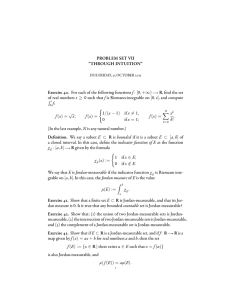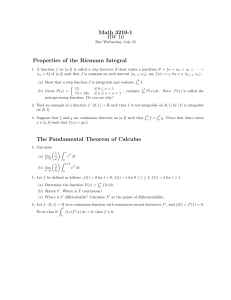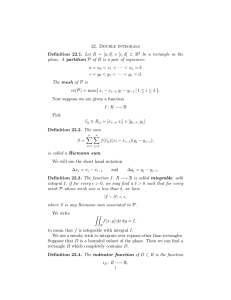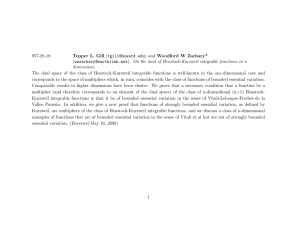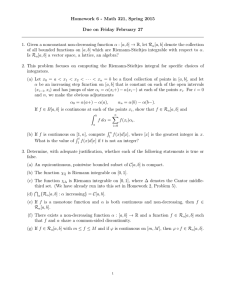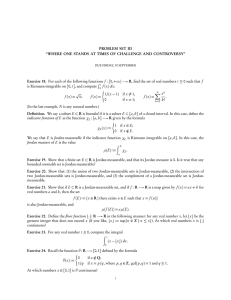24. Triple integrals be a box in space.
advertisement
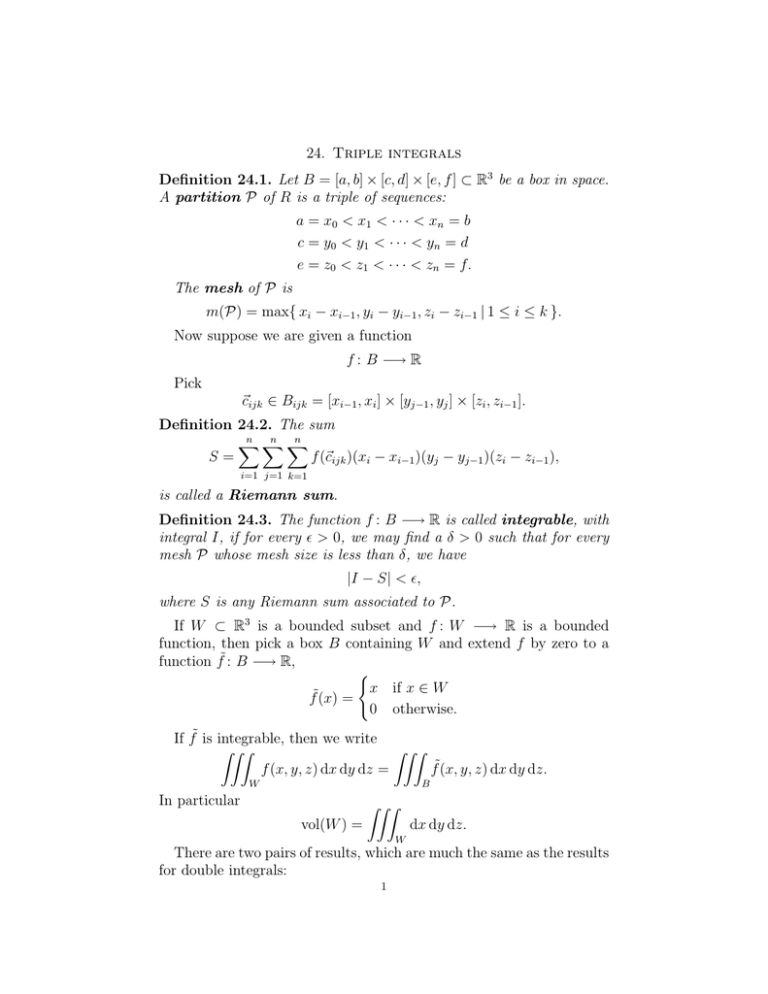
24. Triple integrals
Definition 24.1. Let B = [a, b] × [c, d] × [e, f ] ⊂ R3 be a box in space.
A partition P of R is a triple of sequences:
a = x0 < x1 < · · · < xn = b
c = y0 < y1 < · · · < yn = d
e = z0 < z1 < · · ·
< zn = f.
The mesh of P is
m(P) = max{ xi − xi−1 , yi − yi−1 , zi − zi−1 | 1 ≤ i ≤ k }.
Now suppose we are given a function
f : B −→ R
Pick
�cijk ∈ Bijk = [xi−1 , xi ] × [yj−1 , yj ] × [zi , zi−1 ].
Definition 24.2. The sum
n �
n �
n
�
S=
f (�cijk )(xi − xi−1 )(yj − yj−1 )(zi − zi−1 ),
i=1 j=1 k=1
is called a Riemann sum.
Definition 24.3. The function f : B −→ R is called integrable, with
integral I, if for every � > 0, we may find a δ > 0 such that for every
mesh P whose mesh size is less than δ, we have
|I − S| < �,
where S is any Riemann sum associated to P.
If W ⊂ R3 is a bounded subset and f : W −→ R is a bounded
function, then pick a box B containing W and extend f by zero to a
function f˜: B −→ R,
�
x if x ∈ W
f˜(x) =
0 otherwise.
If f˜ is integrable, then we write
� � �
���
f (x, y, z) dx dy dz =
f˜(x, y, z) dx dy dz.
W
B
In particular
���
vol(W ) =
dx dy dz.
W
There are two pairs of results, which are much the same as the results
for double integrals:
1
Proposition 24.4. Let W ⊂ R2 be a bounded subset and let f : W −→
R and g : W −→ R be two integrable functions. Let λ be a scalar.
Then
(1) f + g is integrable over W and
���
���
���
f (x, y, z)+g(x, y, z) dx dy dz =
f (x, y, z) dx dy dz+
g(x, y, z) dx dy dz.
W
W
W
(2) λf is integrable over W and
���
���
λf (x, y, z) dx dy dz = λ
f (x, y, z) dx dy dz.
W
W
(3) If f (x, y, z) ≤ g(x, y, z) for any (x, y, z) ∈ W , then
���
���
f (x, y, z) dx dy dz ≤
g(x, y, z) dx dy dz.
W
W
(4) |f | is integrable over W and
���
���
|
f (x, y, z) dx dy dz| ≤
|f (x, y, z)| dx dy dz.
W
W
Proposition 24.5. Let W = W1 ∪ W2 ⊂ R3 be a bounded subset and
let f : W −→ R be a bounded function.
If f is integrable over W1 and over W2 , then f is integrable over W
and and W1 ∩ W2 , and we have
���
���
���
f (x, y, z) dx dy dz =
f (x, y, z) dx dy dz+
f (x, y, z) dx dy dz
W
W1
W2
���
−
f (x, y, z) dx dy dz.
W1 ∩W2
Definition 24.6. Define three maps
πij : R3 −→ R2 ,
by projection onto the ith and jth coordinate.
In coordinates, we have
π12 (x, y, z) = (x, y),
π23 (x, y, z) = (y, z),
and
π13 (x, y, z) = (x, z).
For example, if we start with a solid pyramid and project onto the
xy-plane, the image is a square, but it project onto the xz-plane, the
image is a triangle. Similarly onto the yz-plane.
Definition 24.7. A bounded subset W ⊂ R3 is an elementary sub­
set if it is one of four types:
Type 1: D = π12 (W ) is an elementary region and
W = { (x, y, z) ∈ R2 | (x, y) ∈ D, �(x, y) ≤ z ≤ φ(x, y) },
2
where � : D −→ R and φ : D −→ R are continuous functions.
Type 2: D = π23 (W ) is an elementary region and
W = { (x, y, z) ∈ R2 | (y, z) ∈ D, α(y, z) ≤ x ≤ β(y, z) },
where α : D −→ R and β : D −→ R are continuous functions.
Type 3: D = π13 (W ) is an elementary region and
W = { (x, y, z) ∈ R2 | (x, z) ∈ D, γ(x, z) ≤ y ≤ δ(x, z) },
where γ : D −→ R and δ : D −→ R are continuous functions.
Type 4: W is of type 1, 2 and 3.
The solid pyramid is of type 4.
Theorem 24.8. Let W ⊂ R3 be an elementary region and let f : W −→
R be a continuous function.
Then
(1) If W is of type 1, then
���
��
��
�
φ(x,y)
f (x, y, z) dx dy dz =
f (x, y, z) dz
W
π12 (W )
dx dy.
�(x,y)
(2) If W if of type 2, then
���
��
��
�
β(y,z)
f (x, y, z) dx dy dz =
f (x, y, z) dx
W
π23 (W )
dy dz.
α(y,z)
(3) If W if of type 3, then
���
��
��
f (x, y, z) dx dy dz =
W
�
δ(x,z)
f (x, y, z) dy
π13 (W )
γ(x,z)
Let’s figure out the volume of the solid ellipsoid:
W = { (x, y, z) ∈ R3 |
� x �2
a
3
+
� y �2
b
+
� z �2
c
≤ 1 }.
dx dz.
This is an elementary region of type 4.
���
vol(W ) =
dx dy dz
W
⎛ q
⎛ q
⎞ ⎞
� a � b 1−( x )2 � c 1−( x )2 −( y )2
a
a
b
⎝ q
⎝ q
=
dz ⎠ dy ⎠ dx
2
2
y 2
x
x
−a
−b 1−( a )
−c 1−( a ) −( b )
⎛ q
⎞
� a � b 1−( x )2 �
� x �2 � y �2
a
⎝ q
=
2c 1 −
−
dy ⎠ dx
x 2
a
b
−a
−b 1−( a )
⎛ q
⎞
� a � b 1−( x )2 �
� x �2 � y �2
a
⎝ q
−
= 2c
1−
dy ⎠ dx
x 2
a
b
−a
−b 1−( a )
⎛ q
⎞
�
� a � b 1−( x )2 � �
�
�
2
a
2c
x
⎝ q
=
b2 1 −
− y 2 dy ⎠ dx
2
b −a
a
−b 1−( x
a)
�
� a �
�
πc
x �2
2
=
b 1−
dx
b −a
a
� a
� x �2
= πbc
1−
dx
a
−a
�
�a
x3
= πbc x − 2
3a −a
�
�
a3
= πbc 2a − 2 2
3a
4π
=
abc.
3
4
MIT OpenCourseWare
http://ocw.mit.edu
18.022 Calculus of Several Variables
Fall 2010
For information about citing these materials or our Terms of Use, visit: http://ocw.mit.edu/terms.

